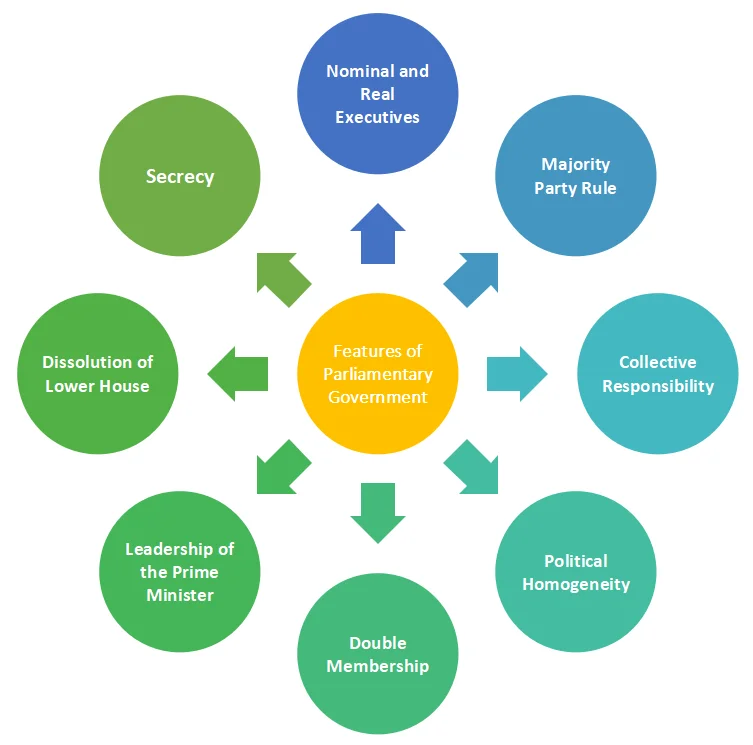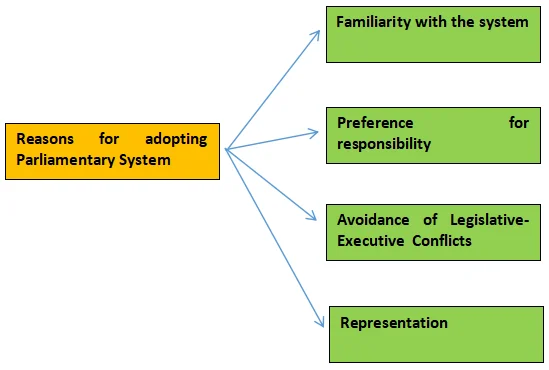India’s parliamentary system, detailed in Articles 74, 75, 163, and 164 of the Constitution, combines elements of the Westminster model with unique adaptations. This system emphasizes the executive’s accountability to the legislature, featuring both nominal and real executives. Unlike the British model, India’s parliamentary system operates within a republican framework and focuses on balancing executive and legislative powers.
Parliamentary System in India: Features, Merits, Demerits, and Comparison
Overview: In the Parliamentary system of government, the executive is responsible to the legislature for its policies and acts.
- This system of government is also known as cabinet government or responsible government or Westminster model of government.
- Examples: Britain, Japan, Canada, and India have a Parliamentary form of government.

- Features of Parliamentary Government
- Nominal and Real Executives: The President is the nominal executive (de jure executive or titular executive) while the Prime Minister is the real executive (de facto executive).
- It means the President is the head of the State, and the Prime Minister is the head of the government.
- Majority Party Rule: The political party which secures majority seats in the Lok Sabha forms the government and the leader of that party is appointed as the Prime Minister by the President; other ministers are appointed by the President on the advice of the Prime Minister.
- Collective Responsibility: The ministers are collectively responsible to the Parliament in general and to the Lok Sabha in particular (Article 75).
- They act as a team and swim and sink together.
- It implies that the Lok Sabha can remove the ministry (i.e., council of ministers headed by the Prime Minister) from office by passing a vote of no confidence.
- Political Homogeneity: Usually, the ministers belong to the same political party, and hence they share the same political ideology.
- Double Membership: The ministers are members of both the legislature and the executive.
- The Constitution stipulates that a minister who is not a member of the Parliament for six consecutive months ceases to be a minister.
- Dissolution of the Lower House: The President on the recommendation of the Prime Minister can dissolve the lower house of the Parliament (Lok Sabha) before the expiry of its term and hold fresh elections.
- This means that the executive enjoys the right to get the legislature dissolved in a parliamentary system.
- Secrecy: The ministers operate on the principle of secrecy of procedure and cannot disclose information about their proceedings, policies and decisions.
-
- They take the oath of secrecy administered by the President, before entering their office.
Enroll now for UPSC Online Course


| Merits of the Parliamentary System | Demerits of Parliamentary System |
|
|
|
|
|
|
|
|
|
|
Reason for Adopting the Parliamentary System
The founding fathers of the Indian Constitution preferred the Parliamentary system due to the following reasons:
- Familiarity with the System: The Constitution-makers were familiar with the parliamentary system as it had been in operation in India during the British rule.
- K.M. Munshi: ‘For the last thirty or forty years, some kind of responsibility has been introduced in the governance of this country.
- Our Constitutional traditions have become Parliamentary.
- After this experience, why should we go back and buy a novel experience?
- K.M. Munshi: ‘For the last thirty or forty years, some kind of responsibility has been introduced in the governance of this country.
- Preference to More Responsibility: Dr. B.R. Ambedkar pointed out in the Constituent Assembly that ‘a democratic executive must satisfy two conditions: stability and responsibility.’
- Avoidance of Legislative–Executive Conflicts: The Constitution-makers wanted to avoid the conflicts between the legislature and the executive which are bound to occur in the Presidential system.
- According to them, an infant democracy like India could not afford to take the risk of a perpetual cleavage, and conflict between these two organs of the government.
- They sought a form of government that would be conducive to the manifold development of the country.
- Representation: India is one of the most complex plural societies in the world.
- Hence, the parliamentary system was adopted which represented various sections, interests, and regions in the government.
- The Parliament System is a better representative system as it involves elections in the country by dividing it into many small constituencies.

Distinction Between Indian And British Models
| India | Britain |
|
|
|
|
|
|
|
|
|
|
|
|
Enroll now for UPSC Online Course
| Must Read | |
| Current Affairs | Editorial Analysis |
| Upsc Notes | Upsc Blogs |
| NCERT Notes | Free Main Answer Writing |
Conclusion
The Indian parliamentary system fosters a cooperative relationship between the executive and legislature, ensuring responsibility and representation. However, it faces challenges like government instability and potential conflicts of interest.
- By adapting the Westminster model to India’s democratic and pluralistic needs, it aims to balance effective governance with constitutional principles.
Sign up for the PWOnlyIAS Online Course by Physics Wallah and start your journey to IAS success today!
| Related Articles | |
| Legislative Procedure In State Legislature | Leader of Opposition in Lok Sabha |
| India’s Parliamentary System | Constitution: A Living Document |

 GS Foundation
GS Foundation Optional Course
Optional Course Combo Courses
Combo Courses Degree Program
Degree Program












